How to convert pdf to excel? Check out this article on how to convert pdf to excel without losing formatting in few and simple steps.
Converting a PDF To an Excel Spreadsheet can be a difficult task. Often times people spend money from places such as oDesk or Fiverr just to have the data extracted, only to get it back in an unusable format. In contrast, you can get that same spreadsheet back in a usable CSV format without spending a dime by following the steps below that teaches you How to Convert a Pdf to Excel.
Table of Contents
Method #1 To Convert PDF Files To Excel: Copy And Paste
The most basic method of bringing data from a PDF file into Excel is to simply copy and paste.
Since some (not all) PDF files allow you to copy data, there are cases where you may be able to bring all the data you require into Excel by using the basic commands of copy and paste.
Let’s take a look at a practical example of how you can copy and paste data from certain PDF files into Excel:
The following screenshot shows a table within a pdf document. More precisely, you can find this table in page 22 of the Working Paper from the European Central Bank titled Inflation forecasts: Are market-based and survey-based measures informative? by Magdalena Grothe and Aidan Meyler.
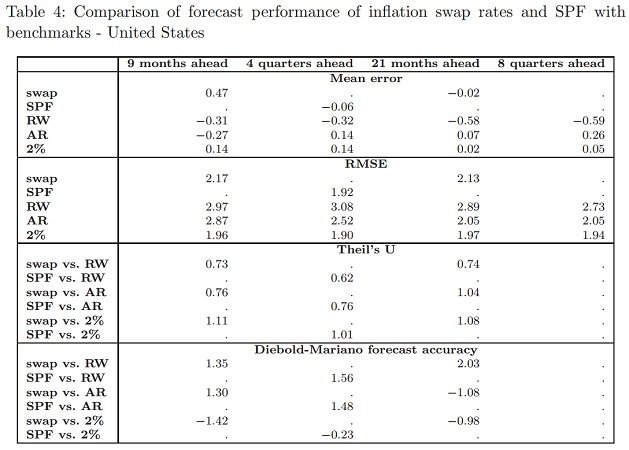
Throughout this blog post, I show the results obtained when applying each of the different methods to convert this table from PDF to Excel. This Convert PDF to Excel Tutorial is accompanied by an Excel workbook containing these results. You can get immediate free access to this example workbook by subscribing to the Power Spreadsheets Newsletter.
Subscribe to the Newsletter and get immediate free access…
to the workbook example that accompanies this Convert PDF to Excel Tutorial.
Get updates and resources that will help you be more efficient and work faster with Excel.
I’ll also send you the FREE workbook example that accompanies this Convert PDF to Excel Tutorial immediately.
Unsubscribe anytime | 100% privacy | Read our Privacy Policy
Step #1: Select And Copy The Data
The first step to copy data from a PDF file is to, simply, select the relevant data and copy it. You can generally use the “Ctrl + C” keyboard shortcut for purposes of copying data.

Step #2: Paste The Data Into Excel
Once you’ve copied the relevant data from the PDF file, and this is available on the Clipboard, you need to go to Excel and paste it.
Even though this sounds easy, in practice it doesn’t work that smoothly. In fact, this step highlights some of the main limitations of this method of converting PDF files to Excel.
You may want to consider:
- Using the Paste Special command; and
- Trying some of the different options that appear.
You can access the Paste Special dialog box by:
- #1: Clicking on the drop-down section of the Paste split button in the Home tab of the Ribbon; and
- #2: Selecting “Paste Special…”.

You can also open the Paste Special dialog box by using the keyboard shortcut “Ctrl + Alt + V”.
In the Paste Special dialog box, you can choose from several options. The following image shows how the Paste Special dialog box looks like when I paste the data from the PDF table that appears above:
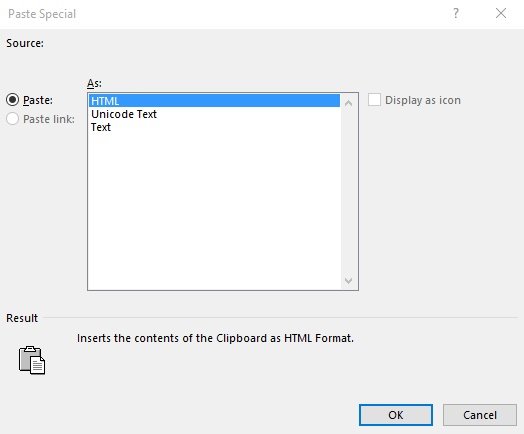
For this example, I select the option to paste as Text and click on the OK button on the lower-right corner of the dialog box.
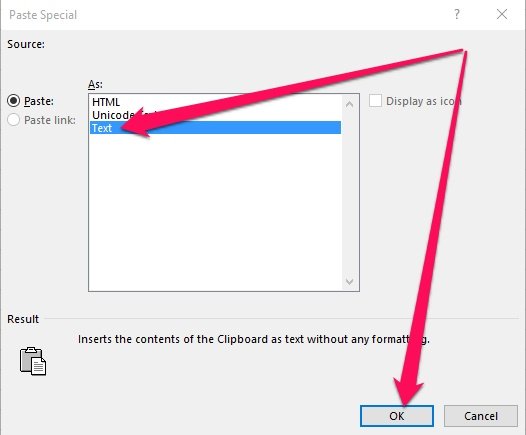
The following screenshot shows the pasted data in the Excel worksheet:

In most cases this isn’t precisely the result you want. However, you’ll rarely be able to get better results when using this method.
As a general rule: Directly copying and pasting from PDF to Excel (usually) results in a single column of data.
This is precisely what happens in the example above. And you can generally expect this to happen whenever following this method.
As a consequence of the above, you’ll usually need to complete the process with the following…
Step #3: Cleanup The Data
Even though pasted data in Excel generally requires some cleanup, you have a variety of tools you can use to make the cleanup easier, faster and more precise.
Since this blog post isn’t about data cleanup, I don’t go into any specific methods. However, some of the tools and features that you may find helpful (depending on the particular situation) are the following:
- Text functions and formulas.
- The Remove Duplicates command.
- Get & Transform / Power Query.
- The Text to Columns command.
- Flash Fill.
I may cover some of these topics in future tutorials within Power Spreadsheets. If you want to receive an email when I publish new material in Power Spreadsheets, please make sure to register to our Newsletter by entering your email address below:
Subscribe to the Power Spreadsheets Newsletter
Join tens of thousands of Excel Power Users.
Get updates and resources that will help you be more efficient and work faster with Excel. Additionally, (almost) every week I send one of the following two emails:
• A short email with an actionable Excel tip; and
• An email with a short VBA code snippet/example.
Unsubscribe anytime | 100% privacy | Read our Privacy Policy
Overall, this first method of converting a PDF file to Excel leaves some things to be desired. The following are, in my opinion, its 2 biggest drawbacks:
- Limitation #1: The method only works when you’re able to copy the data from the PDF file. As you may have experienced, there are times where you are not able to copy data from a PDF file.
- Limitation #2: Any data that you paste into Excel using this method generally unwinds into a single column and requires cleanup. In other words: You may still have to do a substantial amount of work in order to get the data from the PDF file into a form that is ready for analysis.
There are some situations in which you may not have any other option for purposes of converting a PDF file to Excel. This is the case if, for example, you don’t have access to any of the tools that are required to apply the other methods that I explain below.
In any case, as long as you have access to a recent version of Microsoft Word or to Word Online, the following method may help you achieve better results when converting a PDF file to Excel.
Method #2 To Convert PDF Files To Excel: Use Microsoft Word
In order to make use of this method, you need access to one of the following:
- One of the most recent versions of Microsoft Word (2013 or later).
- Access to Microsoft Word online and OneDrive.
In broad terms, the logic behind converting a PDF file to Excel is the same regardless of which of the above versions of Word you use. You, basically, follow these 2 simple steps:
- Step #1: Open the relevant PDF file using Microsoft Word.
- Step #2: Copy the relevant content from the Microsoft Word file and paste it into Excel.
However, let’s take a more detailed look at each of these methods to convert a PDF File to Excel using Word. In both cases, I use the same sample table as above, which you can find in page 22 of the Working Paper from the European Central Bank titled Inflation forecasts: Are market-based and survey-based measures informative?.
Convert PDF File To Excel Using A Recent Version Of Microsoft Word
Let’s start by taking a look at how you can use a recent version of Microsoft Word to convert a PDF file to Excel:
Step #1: Open The PDF File
You can open the PDF file you want to convert using any of several methods, including the following 2:
- Method #1: On the Windows File Explorer: (i) Right-click on the PDF file to expand the right-click menu, (ii) select “Open with”, and (iii) click on Word. In the case of the screenshot below, I open the file using Word 2016 on Windows 10.

- Method #2: Follow these 3 easy steps:
- Step #1: Within Word, click on the File tab of the Ribbon to get to the Backstage View.

- Step #2: Select Open from the pane on the left side of the screen and click on Browse.

- Step #3: Once Word displays the Open dialog box, (i) navigate to the folder where the PDF file is stored, (ii) select it, and (iii) click on the Open button on the lower right corner of the dialog.
 If you prefer using keyboard shortcuts to get to the Open dialog box, you can replace steps #1 and #2 above with a keyboard shortcut such as “Ctrl + F12” or “Alt + F + O + O”.
If you prefer using keyboard shortcuts to get to the Open dialog box, you can replace steps #1 and #2 above with a keyboard shortcut such as “Ctrl + F12” or “Alt + F + O + O”.
- Step #1: Within Word, click on the File tab of the Ribbon to get to the Backstage View.
After you’ve asked Word to open the file, a dialog box (such as the one below) is displayed. This dialog box informs you about the following:
- The PDF file will be converted to an editable Word document. This is perhaps the main key for the whole process of converting a PDF file to Excel using this method.
- The conversion may take a while. This depends on different factors, such as the size of the file you’re converting and the amount of graphics within the file.
- The resulting Word document is optimized to allow text edition. As a consequence of this, the converted Word file will likely look different from the source PDF. This is very likely, in particular, if the file you’re converting has many graphics.
When Word displays this dialog box, click on the OK button.

As mentioned above, the conversion may take a while, so you may have to wait a little before proceeding to the next step.
Step #2: If Necessary, Enable Editing Of The File
Depending on the source of the PDF file, Word may open it in Protected View.

To exit Protected View, follow these 2 easy steps:
- Step #1: Click on the Enable Editing button that appears on the Message Bar.

- Step #2: Word usually displays (as in step #1 above) a message box informing you that Word will convert the PDF file to an editable Word document. When this dialog box appears, click the OK button again and wait until Word completes the conversion process.

Step #3: Copy The Relevant Sections Of The Editable Word Document
Once you’ve completed step #1 and (if necessary) step #2 above, Word displays the original PDF file as an editable Word document.

When you have the editable Word document, select the section that you want to take into Excel. In the example below, I select the same table as in the previous method:

Once you’ve selected the relevant information in the editable Word document, copy it. For these purposes, you can use any of the following methods:
- Method #1: Press the right button of the mouse and select “Copy” from the contextual menu.

- Method #2: Click on the Copy button in the Home tab of the Ribbon.

- Method #3: Use a keyboard shortcut such as “Ctrl + C”.
Step #4: Paste In Excel
By now, you have the information you need in an editable format. Therefore, you can go to Excel and paste it by using, among others, any of the following methods:
- Method #1: Press the Paste button in the Home tab of the Ribbon.
- Method #2: Use the “Ctrl + V” keyboard shortcut.
In the example above, the resulting table (once pasted in Excel) looks as follows:

In some cases, including this example, the conversion from PDF to Excel isn’t perfect.
Notice, for example, how Word hasn’t been able to convert the values in the first section of the table (Mean error) to an editable form. In this case, those values are pasted as an image. Therefore, you must use another method (including those described in this Excel tutorial) to bring them into Excel before being able to work with them.
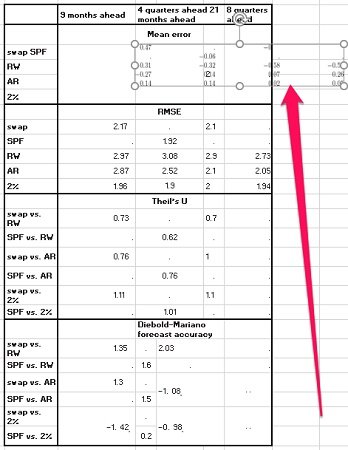
You won’t encounter these shortcomings always. In some cases, this method works just fine.
However, the feature Word uses to convert PDF files to Word documents (called PDF Reflow):
- Works best with simple files that contain (mostly) text.
- Doesn’t handle more complex elements (for ex., tables with cell spacing) very well.
If you encounter problems while using Word to convert a PDF file to Excel, you can always try one of the other methods I describe in this blog post.
Convert PDF File To Excel Using Microsoft Word Online
Even though the process for converting a PDF file to Excel using Word Online is substantially similar to that I followed when using the desktop version of Word, there are a few small differences. Let’s take a look at the 5 easy steps you can use to convert a PDF file to Excel using Word Online.
Step #1: Upload The PDF File To OneDrive
Go to OneDrive and upload the PDF file you want to convert to Excel using either of the following methods:
- Method #1: Dragging the relevant file to the OneDrive window in your browser.

- Method #2: Saving the PDF file in the appropriate folder using the OneDrive app for your computer.

Step #2: Open The PDF File Using Word Online
To open the PDF file using Word online, go to the OneDrive window in your browser, right click on the file and select “Open in Word Online” from the contextual menu.
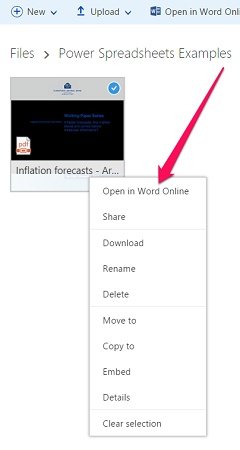
Step #3: Make The PDF File Editable
Once Word online has opened the PDF file, convert it into an editable document by clicking on the Edit in Word button in the upper part of the screen.

Word online displays a dialog box informing you that it will make a copy of the PDF file and convert it into an editable Word document. Confirm by clicking on the Convert button on the lower part of the dialog box.
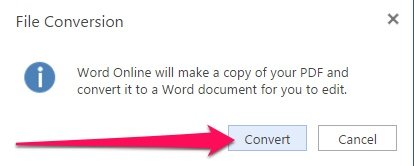
Once Word online has finished the conversion, it displays another dialog box informing you changes in the layout of the PDF file may have occurred. Click on the Edit button on the lower right corner of the dialog box.
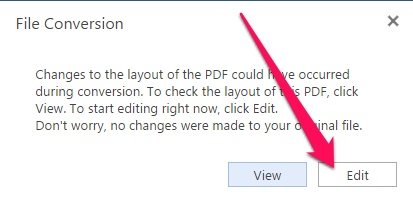
Step #4: Copy The Section Of The Document You Want To Take To Excel
Once Word online has converted the PDF file to an editable document, the screen looks roughly as follows. The actual document will (most likely) be different in your case.
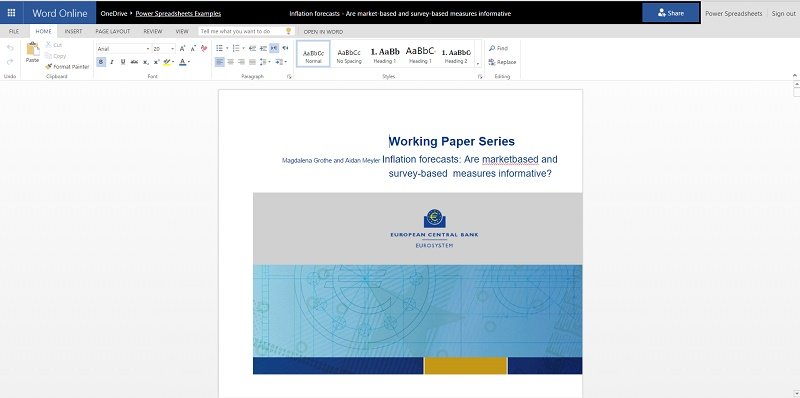
Go to the section of the editable document that you want to bring into Excel, and select it. In the screenshot shown below, I select the same table I use for the previous examples within this Excel tutorial:
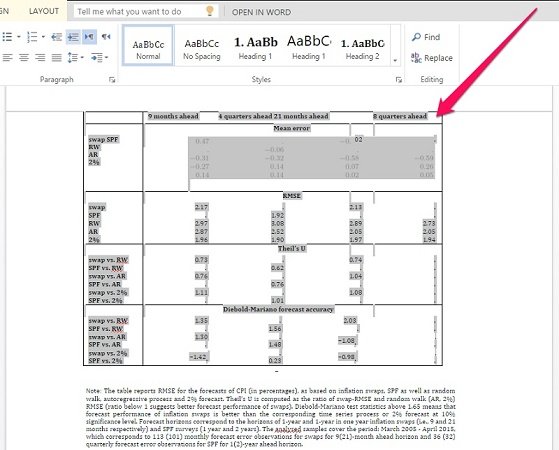
Once you’ve selected what you want, copy it by using the keyboard shortcut “Ctrl + C”.
If you have problems when trying to copy from Word online, you can use the desktop version of Microsoft Word in your computer to continue with the process. To do this, click on the Open In Word button that appears to the right of the Ribbon tabs.

If you choose to open the editable file in Microsoft Word, the desktop version of Word is launched. You can then follow the steps I describe in the previous section to copy the relevant data.
Step #5: Paste The Data In Excel
Once you’ve copied the data, go back to Excel and paste it by using (among others) one of the following methods:
- Method #1: Click on the Paste button.

- Method #2: Use the “Ctrl + V” keyboard shortcut.
The following screenshot shows the resulting table in Excel (after I’ve adjusted the column width):

Not surprisingly, the results are almost identical as those obtained by opening the PDF file with a recent version of Microsoft Word (explained above).
Just as when opening the PDF file with Microsoft Word, you’ll notice that the results aren’t always perfect (although in some cases they will be). In the case of the example displayed above, for example, all the Mean errors (first section of the table) are pasted as an image.

In order to be able to manipulate those values in Excel, you’ll need to bring them using another method (such as the other ones explained in this blog post) or type them directly in Excel.
Method #3 To Convert PDF Files To Excel: Use A PDF Converter
If you have to constantly convert PDF files to Excel or want to avoid the shortcomings of the other 2 methods described above, it may be a good idea to use a PDF converter.
There are several PDF converters in the market. I use Able2Extract.
Even if you don’t end up using Able2Extract, you may want to steer clear of online PDF conversion services when converting sensitive or confidential PDF files. In addition to potential privacy/confidentiality concerns, the results obtained with online converters aren’t always satisfactory.
As a consequence of the above, I show you how to convert a PDF file to Excel using Able2Extract. As when explaining the other methods above, I use the table within the European Central Bank Working Paper titled Inflation forecasts: Are market-based and survey-based measures informative? as an example.
Let’s take a look at how you can convert a PDF to Excel in 6 easy steps when using Able2Extract:
Step #1: Display The Open Dialog Box
In order to get Able2Extract to display the Open dialog box, click on the Open button on the top left corner of the screen or use the “Ctrl + O” keyboard shortcut.
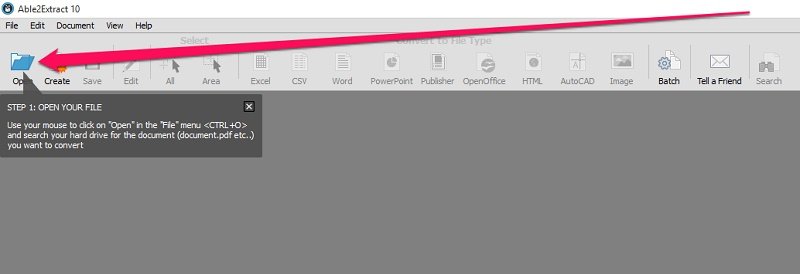
Step #2: Open The File You Want To Convert
Once Able2Extract displays the Open dialog box, use it to browse to the folder where the file you want to convert is located.
Once you’ve located the PDF file to be converted, select it and click the Open button on the lower right corner of the Open dialog box.
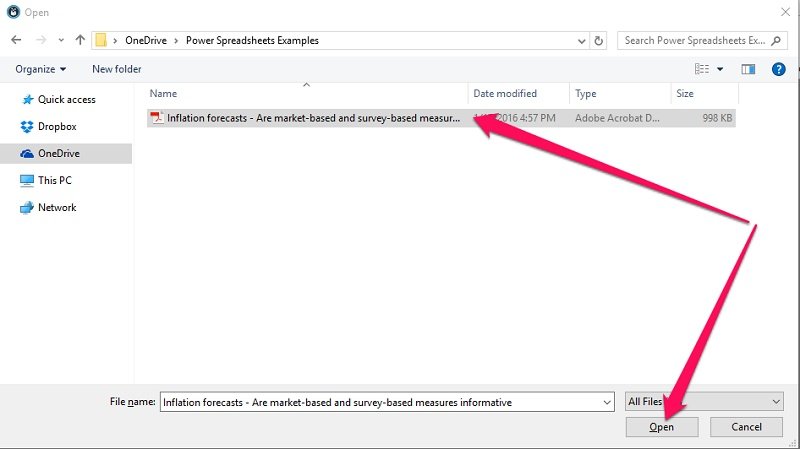
Step #3: Select The Data You Want To Convert
Able2Extract opens the PDF file you want to convert. It also explains how you can select the data you want to convert.

As explained by Able2Extract, you can select data using any of the following methods:
Method #1 To Select Data With Able2Extract
Click on the Select All icon on the toolbar.
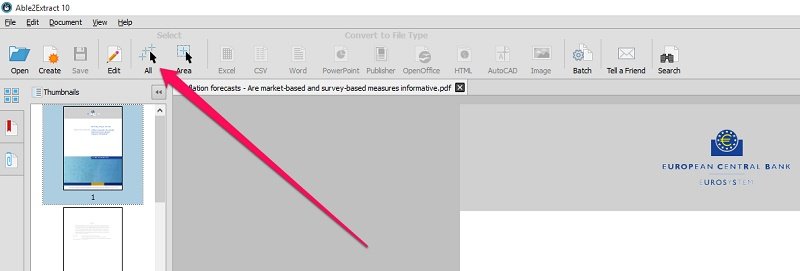
Method #2 To Select Data With Able2Extract
Go to the Edit menu and select any of the following options or use the appropriate keyboard shortcut:
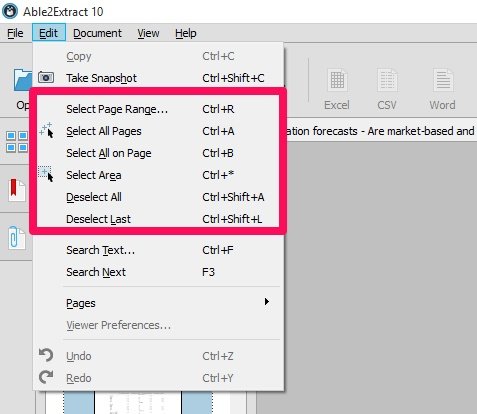
Let’s take a look at each of these options separately:
Option #1: Select Page Range…
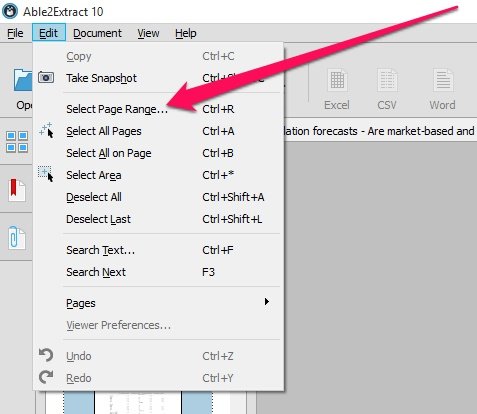
Select Page Range (keyboard shortcut “Ctrl + R”) allows you to select a particular range of pages, without actually selecting all of the content of the PDF file.
Able2Extract displays the Select Page Range dialog box after you’ve clicked on “Select Page Range…” in the Edit menu or used the “Ctrl + R” keyboard shortcut.
You determine the pages to be converter by typing the relevant range and clicking on the OK button on the lower section of the Select Page Range dialog box. For example, to convert pages 21 and 22, you’d enter “21-22” and click “OK”.
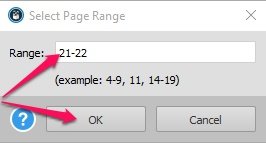
Option #2: Select All Pages.
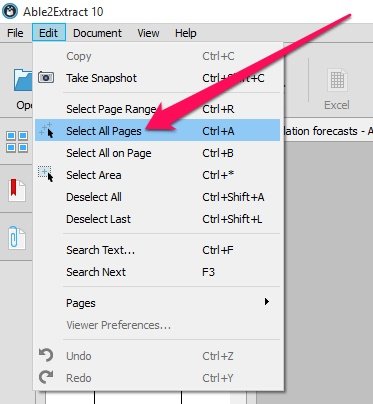
The Select All Pages option (keyboard shortcut “Ctrl + A”) allows you to select all of the pages of the PDF document.
Option #3: Select All on Page.
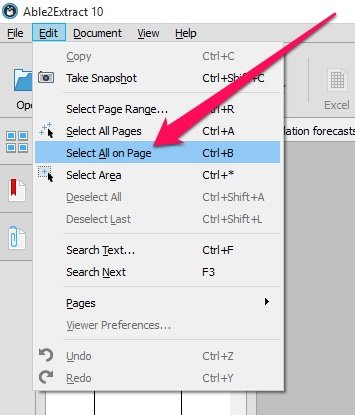
Select All on Page (keyboard shortcut “Ctrl + B”) selects all the data in the current page of the PDF file.
Option #4: Select Area.
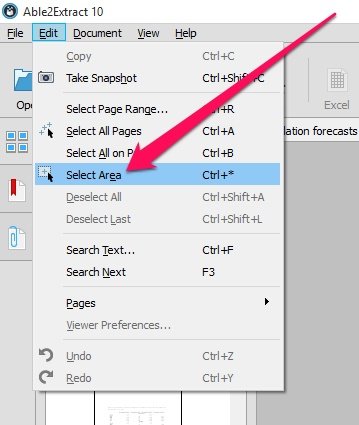
The option to Select Area (keyboard shortcut “Ctrl + *”) allows you to use the mouse to select a particular section of the PDF file to convert.
For example, I can use this option to select the table in page 22 of the European Central Bank Working Paper that I use as an example throughout this blog post.
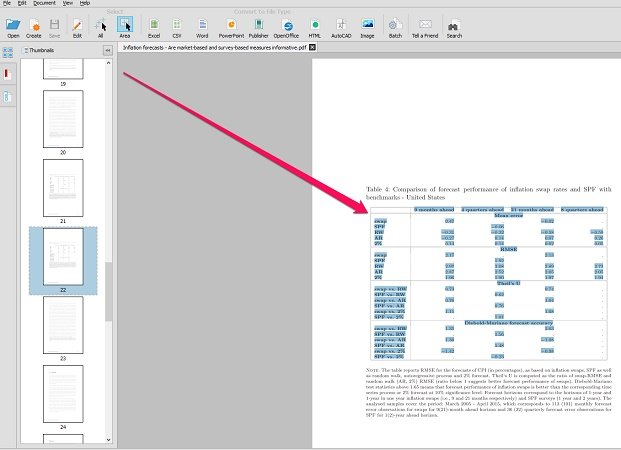
Method #3 To Select Data With Able2Extract
The third way of selecting data with Able2Extract is very similar to using the Select Area option in the Edit menu. Simply use the mouse to select the portion of the PDF document that you want to convert.

Step #4: Select Excel As Output File Type
Once you have selected the data you want to convert from PDF to Excel using any of the methods explained above, click on the Excel button on the toolbar or use the keyboard shortcut “Ctrl + E” to select Excel as the output file type for the conversion.

Step #5: Click On Convert
Once you’ve clicked on the Excel button of the toolbar, Able2Extract provides you 2 options regarding the way in which you want the conversion to occur:
- Option #1: Automatic.
- This is the default option, and is also the recommended choice for most PDF to Excel conversions. If you choose this option, Able2Extract determines the positioning of the columns automatically.
- To choose Automatic conversion, click on the Convert button that appears on the lower left section of the Convert to Excel dialog box.

- Option #2: Custom.
- In the special cases where the Automatic conversion doesn’t work properly (for example, the resulting Excel table isn’t properly aligned), you can use the Custom conversion option to specify the column structure. This allows you to designate the column structure before Able2Extract carries out the actual conversion into Excel.
- To use the Custom conversion option, click on the Define button on the lower middle section of the Convert to Excel dialog.

For this particular example, I choose Automatic conversion. I may explain how to use the Custom conversion option in a future blog post.
Step #6: Save The Excel Spreadsheet
After you click on the Convert button to use Automatic conversion, Able2Extract displays the Save As dialog box.
Use this dialog to select the location and filename of the converted Excel file, and click on the Save button on the lower right corner to confirm your choice. Notice how the Save As dialog box is saving the resulting file as an Excel Spreadsheet.
Once you click on “Save”, Able2Extract converts the selected section(s) of the PDF file into Excel, and launches Excel.
The results I obtain when converting the sample table are shown in the screenshot below. Notice how, among others, Able2Extract was able (i) to replicate the table structure and (ii) extract all of the significant values from the source PDF document.
There’s still some cleaning up work to be done. Notice, for example, how negative numbers have been extracted as text (I highlight one such value below).
These are, however, small issues that are relatively easy to fix.
For example, the negative numbers that are stored as text can easily be converted into actual numbers by using the VALUE function and, if necessary, Excel’s text functions.
If you’re interested in using Able2Extract to convert PDF documents to Excel files, you can download it, and get a 7-day free trial, by following the link below:
Download Able2Extract (affiliate link)
Conclusion
These days it’s hard to imagine any business without an Excel file. With such a big number of spreadsheets, no wonder the need to learn how to convert from pdf to excel file format is constantly increasing.